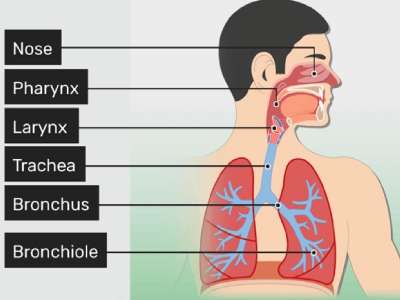What are the 10 parts of the respiratory system?

What are the 10 parts of the respiratory system? so explanation, your respiratory system is a network of organs and tissues that help you breathe. This system helps your body absorb oxygen from the air so that your organs can function. It also clears waste gases from your blood, such as carbon dioxide. Common problems include allergies, illnesses, or infections.
What is the respiratory system?
It includes your airways, lungs, and blood vessels. The muscles that strengthen your lungs are also part of the respiratory system. These parts work together to carry oxygen throughout the body and clean up waste gases such as carbon dioxide.
Respiration consists of two functions:
Inhaling: The process of breathing in oxygen.
Exhaling: The process of breathing carbon dioxide.
Main parts of the respiratory system?
The respiratory system is made up of organs that exchange oxygen and carbon dioxide.
There are the following parts of the respiratory system and short process or function;
- Nose: The nose is the only part of the respiratory system visible externally and is the passage of air into the respiratory system.
- Mouth: The mouth, also called the oral cavity, is the secondary external opening to the trachea. Most common breathing is through the nasal cavity, but the oral cavity can be used to supplement or alter the nasal cavity's functions when needed.
- Throat: The throat (larynx and larynx) is a ring-like muscle tube that acts as a passage for air, food, and fluid. It is located behind the nose and mouth and connects the mouth (oral cavity) and the nose to the respiratory tract (trachea [windpipe] and lungs) and the esophagus (esophagus).
- Windpipe (Large airways): The windpipe (trachea) is the most significant airway. The trachea branches are made up of two small airways: the left and right bronchi, which cause two lungs. Each lung is divided into parts: three in the right lung and two in the left lung.
- Voicebox: The larynx, also called the voice box, is a hollow, tubular structure attached to the top of the windpipe (trachea). The air is blocked in the way of the lungs. The larynx also produces sound and prevents food and other foreign particles' passage into the lower respiratory tract.
The upper respiratory tract contains:
- Lungs: The lungs are the center of the respiratory system. So every cell in the body needs oxygen to stay alive and healthy. Your body also needs to get rid of carbon dioxide. This gas is a waste product that is made by the cells in their usual and daily activities.
- Nasal cavity: The nasal cavity is the inner nasal cavity. The front, the fistula, or the nurses, create holes for the outside world. The air is inhaled through the fistula and warmed by it as it travels further into the nasal cavity. Scroll-shaped bones form the back of the nose, dilated, and places where air passes.
- Larynx: The larynx, commonly called the voice box or glottis, is the airway between the upper larynx and the lower trachea. Its range is from the fourth to the sixth vertebral level. The larynx is often dividing into three parts: the Sublarynx, the larynx, and the Spheronex.
- Trachea: The trachea, commonly known as a windpipe, is a tube that is about 4 inches long and less than an inch in diameter in most people. The trachea begins just below the larynx (voice box) and runs behind the sternum. The trachea then divides into two smaller tubes called bronchi: one bronchus for each lung.
- Sinuses: The sinuses help regulate the temperature and humidity of the air you breathe, as well as lighten the skeletal structure and tone your voice. The nasal passages are the best inlet for external air into your respiratory system.
Lower respiratory tract:
- Bronchi & bronchioles: As it gets closer to the lung tissue, its bronchi become smaller, and then it is considered bronchial. These passages then turn into tiny air sacs called alveoli, the exchange points for oxygen and carbon dioxide in the respiratory system.
- Air sacs: Small sacs at the end of the bronchioles (small branches of the airways in the lungs). Alveoli are the places where the lungs and blood exchange oxygen and carbon dioxide during respiration and the process of respiration.
- Lungs: Already detailed in the above section.
How can I make my respiratory system healthy?
Being able to clear mucus from the lungs and airways is essential for respiratory health.
To keep your respiratory system healthy, only you need to below some points:
- Avoid pollutants that can damage your airways, including secondhand smoke, chemicals, and radon (a radioactive gas that can cause cancer). Wear a mask if you are exposed to smoke, dust, or other contaminants for any reason.
- Avoid smoking yourself.
- Exercise regularly to keep your lungs healthy.
- Eat a healthy diet with plenty of fruits and vegetables and water to stay hydrated.
- Attend the expert meeting, and free online classes for know keep healthy and educated.
- Prevent infection by washing your hands often and getting the flu vaccine every year.
- Comment
- Posted by Muhammad Nazeer